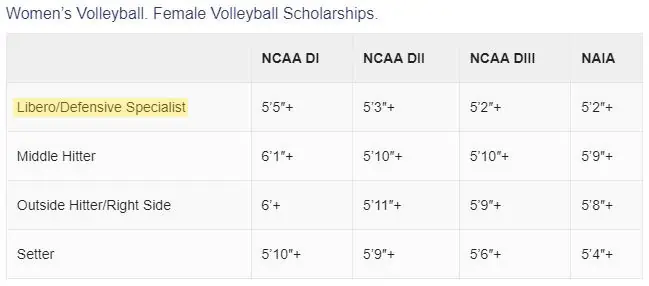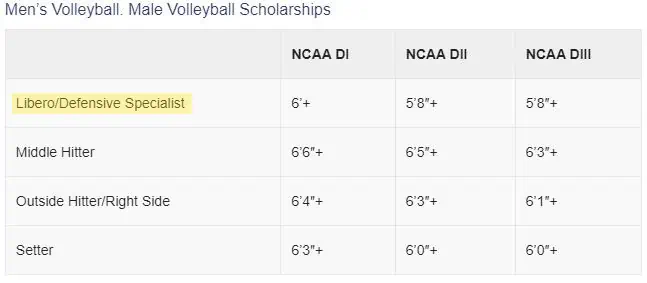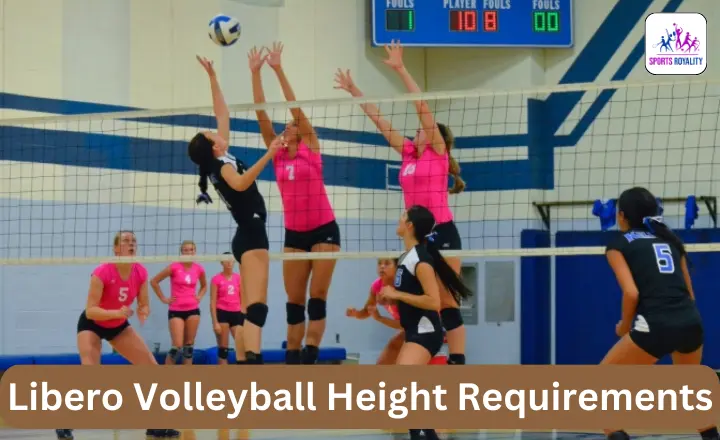The height of players often plays a significant role in their positions and abilities on the court. While towering blockers and powerful hitters are commonly associated with the sport, one position defies this convention the libero. Known for their incredible defensive skills and agile movements, liberos bring a unique dynamic to the game. But what exactly is the ideal height requirement for a libero? We will delve into the intriguing world of libero volleyball height requirements, uncovering how these pint-sized powerhouses make their mark on the court.
What’s The Average Height Of A Libero?
There is often a misconception that height plays a significant role. They couldn’t be further from the truth. Unlike other positions on the team, where height can be an advantage in blocking or spiking, being tall is not required for a successful libero.
Average Height Of A Libero Vs Other Positions:
The contrast in height between liberos and other positions in volleyball is striking. The 2012 Olympics data showed that setters were a staggering 10cm (4 inches) taller than liberos, highlighting the physical disparity between these crucial positions. This discrepancy can be attributed to their different roles on the court.
At the same time, setters orchestrate plays and assist with offence and defence. Liberos specialize in defensive skills and play a pivotal role in the reception and ball control.
Not only are liberos shorter compared to setters, but they also face a significant height disadvantage compared to middle blockers. Middle blockers were found to be over 8 inches taller than their libero counterparts during the same Olympic tournament.
This height difference can greatly affect the dynamics of a game, as middle blockers have an easier time inhibiting attacks due to their superior reach at the net.
It’s important to note that despite this size disadvantage, effective liberos make up for it with exceptional agility, reflexes, and anticipation skills that allow them to excel defensively.

Average Libero Height In The Olympics:
The average height of Olympic liberos, 185cm or 6 feet, reveals an interesting trend in the sport. Coaches seem to prefer taller players for the libero position, perhaps because of their ability to cover a larger area on the court. This does not mean shorter liberos are less skilled or effective.
Looking at Team USA’s roster from the 2012 Olympics, we can see a mix of heights among their liberos:
- Erik Shoji at 184cm
- Kyle Dagostino at 175cm
- Mason Briggs at 183cm
This tells us that height may play a role in determining who gets selected for the libero position at the Olympic level. Still, it is not necessarily a defining factor. Regardless of height, skill and agility are paramount in succeeding as a libero. Perhaps shorter liberos bring other assets to the game that make up for their lack of height, such as speed or exceptional reflexes.
Average Libero Height In College Volleyball:
While height can sometimes be an advantage in other positions on the court, liberos break the mould by excelling in their technical abilities rather than towering over opponents.
There is a range across different divisions to the average height for men’s college volleyball liberos.
- In Division D1, liberos typically measure between 5’8 to 6’2 (173cm to 188cm).
- In Divisions D2 and D3, this range remains relatively similar at 5’8 to 6’1 (173cm to 185.5cm).
- In NAIA competitions, we see a slight increase with liberos ranging from 5’8 to 6’3 (173cm to 190.5cm).
Compared to the average female volleyball libero height in College, there are interesting trends across different divisions.
- In Division D1, the average height of a libero is around 5’6 (168cm). This may come as no surprise, given the competitive nature of this division and the athleticism required to thrive at this level.
- Moving down to Division D2, we see a slight decrease in average height, with liberos measuring around 5’5 (165cm). While this difference may seem marginal, it could indicate that players in this division focus more on speed and agility than sheer height.
- In Division D3 and NAIA, where most student-athletes are recruited from smaller high schools or have unique skill sets, liberos tend to be around 5’5 (165cm).
How Important Is Height For A Libero?
With taller players being assumed to have an advantage on the court.
Height Is Almost Completely Inconsequential:
The primary role of a libero is to excel in defensive skills, such as digging and passing the ball accurately to the setter. These skills rely more on technique, agility, and quick reflexes than height.
While it is true that the average height of liberos is around 6 feet for men, there are professional liberos who are significantly shorter. For example, Farhad Zarif of Iran, who stands at 5’5 (165cm), is the shortest libero in men’s volleyball. Other liberos around this height have also proven highly skilled and effective in their positions. The player’s ability and expertise matter most in determining their success as a libero, not their height.
Can You Be Too Tall To Play Libero?
While there is no strict height limit for playing libero in volleyball, being too tall poses some challenges. Generally, shorter players have an advantage in digging due to their lower centre of gravity and ability to move quickly.
Taller players may find it more difficult to get low enough to make accurate digs and struggle with agility and quick movements on the court.
It’s important to note that every player is unique, and there have been successful liberos taller than 190cm. A taller player with exceptional speed, agility, and strong defensive skills can still excel in the libero position.
Libero Volleyball Height Requirements For Scholarships:
Libero Volleyball height requirements for volleyball scholarships: no set rule or standard height guarantees eligibility.
Being 5’5 or taller may be advantageous for women due to its potential reach and court coverage. There are successful liberos who are shorter than this threshold but compensate with exceptional speed, agility, and defensive instincts.

For men, while a height of 6 feet or more may offer advantages in blocking and hitting ability, it does not necessarily determine one’s capability to excel as a libero.

Instead Of Height, Liberos Should Focus On These Areas:
Your main focus should be on your defensive skills and your ability to read the game. Height may give you an advantage in certain situations, such as blocking at the net, but it is not the determining factor for success in this position.
If you aspire to excel as a libero in volleyball, only 2 crucial aspects demand your undivided attention.
Passing Consistency:
Passing consistency is a skill that cannot be underestimated. A libero who can consistently make accurate passes under pressure provides stability and confidence to the entire team. They act as the backbone of the defence, allowing the setters to execute effective plays.
While height may offer advantages in blocking or attacking, it does not guarantee consistent passing. Taller players may struggle with mobility and getting into proper defensive positions quickly.
Liberos should improve their passing consistency through practice and technique rather than obsessing over their height. Working on footwork, body positioning, and reading the game is more beneficial than worrying about being shorter than other players on the court. By mastering these skills, a libero can become an asset to any team by consistently delivering precise passes that lead to successful attacks.
Digging Consistency:
Watching a libero like Jenia Grebennikov in action is a masterclass in digging for consistency. This French volleyball player has made a name for himself with his exceptional technique, lightning-fast reflexes, and unwavering determination on the court. What sets him apart from other liberos is his physical abilities, mental strength, and tactical intelligence.
Grebennikov’s technique is impeccable. His body positioning allows him to react quickly to incoming spikes and accurately direct the ball towards his teammates. His footwork is smooth and precise, enabling him to cover the court efficiently and reach balls that seem impossible to dig. But it’s not just about physical prowess.
Grebennikov understands the game intricately. He anticipates where the attackers will hit, reads their body language, and adjusts his position accordingly. This combination of technical skill and strategic thinking makes him a force to be reckoned with on defence.
Final Words:
The Libero Volleyball height requirements are not set in stone. While there may be average heights for this position, it ultimately comes down to a player’s skill set and ability to excel on the court.
Taller liberos may have an advantage in blocking and reaching higher balls, but shorter liberos can compensate for it with their speed, agility, and defensive prowess. Teams and coaches must focus on finding well-rounded players who bring various skills to the table rather than solely focusing on height.

